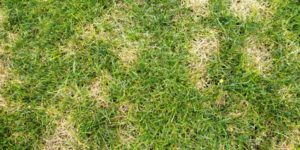Common Grass Diseases
 Just like any other living organism, grass can catch diseases which is typically caused by fungi. Naturally, lawns are full of fungi and spores and the right conditions can cause grass fungus to quickly develop into a harmful disease. If you see dead areas in your lawn, white thin threads going from blade to blade, blades going from green to red to brown or slime, you may be dealing with a lawn disease.
Just like any other living organism, grass can catch diseases which is typically caused by fungi. Naturally, lawns are full of fungi and spores and the right conditions can cause grass fungus to quickly develop into a harmful disease. If you see dead areas in your lawn, white thin threads going from blade to blade, blades going from green to red to brown or slime, you may be dealing with a lawn disease.
Prevention is always the best strategy for managing common lawn diseases…below are tips on how to keep your lawn in optimal health making it less prone to disease:
- Aerate and overseed your lawn to help loosen soil and break down thatch encouraging a healthy lawn.
- Conduct a soil test to help identify what nutrients your lawn is lacking. Lawn health starts from below the surface with proper fertilization. Under and over-fertilization can promote disease in lawns.
- Water only early in the morning will allow the grass blades to dry during the day. Watering in the evening or at night encourages disease because of excess moisture
- Follow good mowing practices by keeping your mower blades sharp and mowing your lawn to the correct height. If your lawn has diseased patches, be sure to disinfect the underside of your mower after each use so you do not spread to non affected areas.
- If possible, thin out trees and shrubs to allow better air circulation.
Maintaining good mowing and watering practices, proper fertilization, and aerating and seeding can help to prevent serious problems. Although a change in your lawn care maintenance may be sufficient in eliminating or preventing a lawn disease, in some cases a fungicide will need to be carefully applied to help control the disease and to prevent it from spreading.
The most common lawn diseases affecting lawns in our area are:
Brown Patch
Tall fescue and bluegrass can be affected by a brown patch—a fungus that can create circular brown patches throughout your lawn. The blades of grass first turn purplish-green, wilt, and then turn light brown. Rot can set in and your lawn will show irregular brown spots from an inch to several feet in diameter. It often appears when there are warm, humid conditions.
Dollar Spot
A common disease in Maryland and Virginia is dollar spot. Dollar spot can occur in late spring through fall, although most damage occurs during June and July. Dollar spot is more prevalent in under-fertilized turf and in compacted soil with a thicker thatch layer. Typically, it looks like an hourglass-shaped lesion with a dark border surrounding a whitened center, producing many 2-6 inch spots.
Fairy Rings
This fungus prevents roots from taking in water, oxygen, and nutrients. Mushrooms appear in bands or circles and can be from 3-50′ in diameter. Grass often appears greener in affected areas.
To get rid of this fungus, begin by stripping off any dead turf and replace infested soil before re-sodding. Sod will be tight and hard. Use a root feeder to soak nearby grassroots, starting about 2 feet away and working towards the infested area. Soak several times to ensure the roots of your new grassroots takes hold in the soil.
Click here to learn how to identify, prevent and treat fairy rings
Fusarium Blight
This is a fungal disease that attacks lawns that are highly exposed to the sun and are made up of either Kentucky bluegrass, red fescue, or bent grasses. Fusarium blight will cause small brown rings to appear in early summer. To remove the fungus, begin by heavily soaking your lawn and avoid frequent light soakings. Then, dethatch and apply lime treatments to your lawn to avoid acidic soil. Finish up by applying high-Nitrogen fertilizers.
Powdery Mildew
Warm, humid days and cool nights favor mildew in bluegrass and fescues. The grass shows a gray-white, white, or brown mold on the leaf blades, often in shady areas with low air circulation and poorly draining soil. Avoid over-watering during hot humid weather and increase the amount of sunlight to the affected area.
Red Thread
Red thread is a common turf disease most frequently occurring in cool wet weather during the spring and fall. Red thread produces a reddish fungal growth seen on leaf blades and after the leaves dry is when it appears to look like small pieces of red string laying in your turf. Usually, the turf has circular patches from 2 inches to 3 feet in diameter.
Click here to learn how to identify & treat red thread disease
Rust
Rust affects bluegrass, ryegrass, bermudagrass, zoysia and tall fescue grass. Orange or red-brown blisters appear on the blades of your grass, causing it to wither and die. The blisters burst and the spores move on to infect healthy grass. In order to stop the spores in their tracks, mow the lawn as soon as it grows to a 1/2 inch and catch and remove all clippings.
Smut or Stripe Smut
Bluegrass and bentgrass are most affected by this fungus in cool spring and fall weather. Leaves develop black or gray stripes that rupture and discharge black spores infecting healthy grass. Diseased grass is stunted and begins to turn a yellow-green color while the leaves curl and shred before dying. To remove this fungus, seed your lawn with a blend of bluegrass seeds that is more resistant to smut.
